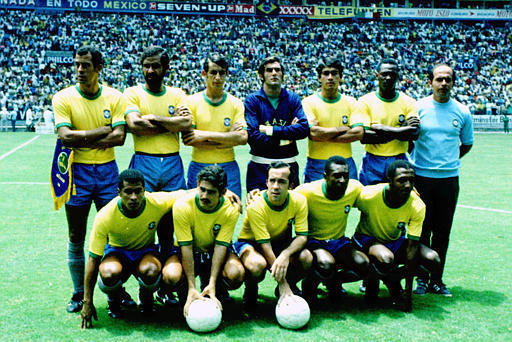At Mexico 1970 Fifa World Cup, samba magic had reached its peak. It was the first World Cup to be broadcasted across the world in color, and the men in canary yellow performed on a level seldom touched before or since, and routinely reduced opponents to wide-eyed spectators at a footballing masterclass. Let’s have a look at their team.
With the 1970 World Cup mere months away, Brazil was looking promising. They had won all their games in the qualifying rounds despite the manager, João Saldanha, failing to accommodate all the star names in his line-up. Most controversially and to much of Brazil’s dismay, Saldanha saw no logic in starting both of Brazil’s deadliest attackers, Pelé and Tostão. He was replaced by a member of Brazil’s 1958 and 1962 World Cup winning squads, Mário Zagallo. Zagallo had one main initiative: to field Brazil’s best under one tactic. Brazil had a plethora of number 10s – Rivellino, a slick dribbler with an atomic left foot, Jairzinho, a fast dribbler with the strength and incision to pass any man, Gérson, a midfield maestro with the passing range to hit any tree, and the aforementioned Pelé and Tostão. Zagallo used the 4-2-4 formation Brazil played at the 1962 World Cup as the blueprint tactic for this team. In goal stood Félix, Carlos Alberto – the captain of the side – Piazza, Brito and Everaldo made up the back four, Clodoaldo and Gérson operated as the midfield pivot, Jairzinho and Rivellino occupied the right and left flanks respectively, and Pelé and Tostão were the striking partnership. There were, however, a number of tactical tweaks. Pelé played slightly deeper than Tostão. He was the pivotal playmaker, the closest to a classic number 10. Tostão, wearing the famous number 9, resembled more of a false 9. He roamed across the front line, often dropping deep to contribute to the build-up play and destabilize the opponent’s defence. With the centre-backs following Tostão’s runs, space would be created for Pelé or Jairzinho, the latter cutting inside from the right.
Rivelino was a more unorthodox winger. He would drift into the centre, consequently creating a three-man midfield with Clodoaldo and Gérson, or taking up more attacking positions near Pelé. Carlos Alberto was instructed to bomb down the right flank when Brazil were in possession, leaving Piazza, Brito and Everaldo to cover for the whole team. Piazza was actually a midfielder; Zagallo insisted on him playing in defence to help with Brazil’s build-up play. Thus, with mere weeks to go until the World Cup in Mexico, a sudden managerial change, and a nation suffering under oppression once more, meant the capoeira mentality held more prevalence than ever. Brazil looked to their 23 travelling players for some sort of escape. Few fans, albeit reluctantly, rooted against the Seleção, hoping their shortcomings would embarrass Médici enough to leave office. But to the nation as a whole, Zagallo’s men were to be an indicator of the future – if Pelé and co could succeed in such times, then Brazil could too. Luckily, they were enchanting. It was their story: an oppressive dictator presiding over a country in peril and a team gunning for glory to salvage some form of happiness for its despairing countrymen. It was their players: strong, fast, skilled, each capable of inventing a priorly unseen moment of magic. It was their football: quick, imaginative, and full of flair, Brazil set the precedent for a fluid and potent offence. It was joga bonito – the zest to play beautifully. Brazil’s 1970 World Cup win was special for many reasons – a record-breaking third title; winning all games on their way to the title, including each of their qualifying fixtures; Pele the only player to ever win three world championships; Jairzinho’s as-yet unrivalled record of scoring in every finals match; Coach Mario Zagallo the first man to win the World Cup both as a player and a coach.
But most importantly, in a tournament characterized by positive, flowing, attacking play, Brazil went a step further in crystallizing these qualities into something that sparkles even 48 years later in a completely unrecognizable footballing spectrum. Flamboyant, sometimes outrageous, but never needlessly so, with a languid quality that belied their razor-sharp concentration on creating space and music with the ball. They earned their redemption and passed into legend showcasing the best of what the sport is capable of; the beauty that is possible when we work together in sync, in tandem, as opposed to individual flashes of brilliance. Over the years the World Cup has seen some great sides. There are fond memories of the Dutch sides that failed to win in 1974 and 1978 World Cups, Brazil 1982 are another great side that didn’t win it, others love the Italian teams that won back to back titles in the 1930’s or Argentina’s team that were inspired by Diego Maradona to win the 1986 tournament or Spain’s famous 2010 side that won the World Cup. However, throughout history the one that outranks them all is the sublime Brazilian side from 1970 that brought flair and style to the competition which led a football obsessed nation to their third World Cup in 12 years.
![]()

